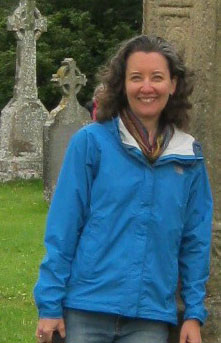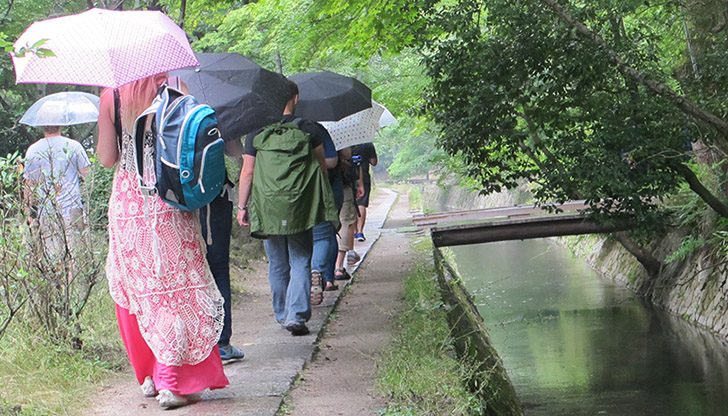Through the Back Door: Interdisciplinarity in Short-Term, Faculty-Led Study Abroad Programs
Introduction
Finding the time and the financial resources for study abroad is a challenge for most students at my university, where many of them are first-generation learners and have work and/or family commitments. New adventure and global awareness may seem like unaffordable and impractical luxuries to them, and therefore they are not sufficient points of appeal for recruiting participants for my school’s only study abroad opportunity (in Ireland). Students must be able to justify the additional expense and time commitment by taking classes within the study abroad program that they need to graduate, whether those are core requirements or major courses.
Spalding University’s short-term, faculty-led study abroad in Ireland program thus involves collaboration with faculty from different departments to offer a variety of courses and to plan the activities during the two-week trip to Ireland. Past iterations of our program have involved successful collaborations between me (a liberal studies faculty who teaches religious studies), a liberal studies literature professor, and a faculty member in social work. Spalding requires two religious studies courses and one literature course as core requirements; classes in those disciplines also contribute to interdisciplinary liberal studies majors. Social work classes at Spalding are only open to majors in their department, but the course offered in the program was also cross-listed, so it was available to psychology majors as well. Thus the course offerings (Irish Religion and Culture, Irish Literature, Social Work in a Global Community, and International Psychology) could appeal to all students seeking core requirements but also to some specialized majors.
While students are attracted to the program based on what individual courses they will take, the classes, as well as the trip itself, quickly emerge as holistic and interdisciplinary. Study abroad in Ireland is designed so that all students in the program meet together for two hours, once a week, for the four weeks leading up to two weeks of travel (Spalding University operates on six-week sessions). Students meet the same amount, on the same time frame, for their individual courses. During the time when all participants are together, students not only become better prepared to travel abroad (in 2014 several students had not been on an airplane before; all but one student had never been out of the United States), but also are given an overview of Irish history and culture. Then when they meet in their individual classes, they can begin to make connections between their more specialized course work and the “big picture” of Ireland. While on the trip, all students are expected to participate in all organized activities, such as visits to significant historical religious sites, discussions with social services providers, and attendance at plays and poetry readings, so students get much more from their educational experience than what they signed up for.
Maximizing the Interdisciplinary Nature of Religious Studies for Study Abroad
Those of us who teach religious studies already know that through our engagement in an interdisciplinary subject-field rather than a narrow discipline (Capps, 1995, 331), religious studies has the capacity to address multiple facets of human experiences. What I have learned both by leading a short-term study abroad program and by teaching in a department that only has interdisciplinary majors (at a school where most majors are in professional training programs) is the importance of being explicit with ourselves and with our students about the benefits that religious studies has to offer precisely because of its interdisciplinarity. Students’ experiences with a new culture (or with their own, for that matter) will not be narrowly confined either to a singular topic or a particular approach, and need to be understood in their complexity. Religious studies course offerings are thus an ideal starting place for shaping short-term study abroad programs, whether alone or in collaboration with other disciplines.
Religious studies also offers techniques that are beneficial for students’ approaches to and understandings of the new situations they will encounter in their diverse study abroad experiences, whether those situations are explicitly religious or not. Explaining bracketing to students helps them to be more self-aware of their own personal beliefs and habitual ways of understanding the world so that they can be open to different ideas and cultural practices with less judgment. Employing both a hermeneutics of affection and a hermeneutics of suspicion invites empathy in unfamiliar situations as well as permission to think about problems and pitfalls (Nash, 2003, 211–212). On our last trip to Ireland, I saw students employing these techniques as they shared their experiences and analyses of many different situations. Religiously conservative students who were exposed to Dominican nuns advocating evolution awareness and creation-care theology recognized that while they may not agree, they could understand how the environmental perspective related to Celtic spirituality had a different relationship toward the land. Students who had prior experience to TV reality shows like My Big Fat Gypsy Wedding could see beyond their stereotypes when exposed to systematic discriminatory government policies and cultural attitudes toward Travellers, yet students could also refrain from flipping their views into idealism about Traveller lifestyles and behaviors. Students with no prior personal exposure to homelessness or drug addiction were challenged when visiting a safe house that offered clean needle exchange and an injection room, and they could discuss both the pros and cons of the services. Other disciplines certainly teach analogous methods to bracketing, hermeneutics of appreciation, and hermeneutics of suspicion, but I have found that explicitly identifying these techniques and then walking students through how they are employed are beneficial exercises outside of the specific context of religious studies, and can thus invite complex and integrated modes of thinking.
“Everything I learned will continue to help me in many years to come.”
The National Academies report Facilitating Interdisciplinary Research (2004) defines interdisciplinary education as that which “integrates information, data, techniques, tools, perspectives, concepts, and/or theories from two or more disciplines or bodies of specialized knowledge to advance fundamental understanding or to solve problems whose solutions are beyond the scope of a single discipline or area of research practice” (2). If given the proper tools for analysis and models of collaborative thinking, when exposed to the lived culture of Ireland, students come to realize that they cannot understand religious conflict if they don’t also learn about Irish history and the complexities of political and economic power. Contemporary social work policies are not only about changing ethics in the present, but the factors that have contributed to religious conservatism in the past. The psychology of identity is tied to long cultural memories and family histories, bound up with religious and political allegiances, regionalism, and nationalism. Irish literature reflects all these factors, as well the beauty and spirit of the land, which only makes sense when seen and felt firsthand. As one student in Spalding’s Study Abroad in Ireland Program wrote in her journal, “Throughout our trip we constantly [learned] from different disciplines, like religious studies, history, and psychology. All of these things [together] provide a broader picture…[about what] makes us human.…This will help me grow and learn and simply be better. Everything I learned in the past two weeks will continue to help me in many years to come.”
The benefits of study abroad programs for cultivating cross-cultural and global awareness are obvious. While this consciousness is an important part of developing complex thinking skills, other aspects of a holistic study abroad experience can help to provide students with tools to explore the multifaceted real-life issues that they encounter both abroad and at home (Newell 2010).
Resources
Capps, W. H. 1995. Religious Studies: The Making of a Discipline. Minneapolis: Fortress Press.
National Academies. 2004. Facilitating Interdisciplinary Research. Retrieved from http://www.nap.edu/openbook.php?record_id=11153
Nash, K. S. 2003. “The Study of Religion.” In A Student’s Guide to the Liberal Arts, edited by Wilburn T. Stancil, 196–215. Kansas City: Rockhurst University Press.
Newell, W. H. 2010. Educating for a Complex World: Integrative Learning and Interdisciplinary Studies. Liberal Education 96 (4), (n.p.). Retrieved from http://www.aacu.org/publications-research/periodicals/educating-complex-world-integrative-learning-and-interdisciplinary
 Dorina Miller Parmenter, PhD, is an associate professor of religious studies at Spalding University in Louisville, Kentucky. She teaches very broadly in religious studies, coteaches an introductory interdisciplinary liberal studies course, and is the faculty leader for Spalding's Study Abroad in Ireland program. Dori received her PhD from Syracuse University in 2009 after completing the dissertation, "The Iconic Book: The Image of the Christian Bible in Myth and Ritual." Recent publications include articles in the journal Postscripts (and reprinted in Iconic Books and Texts, edited by J. W. Watts, Equinox, 2013), The Death of Sacred Texts: Ritual Disposal and Renovation of Texts in the World Religions (edited by K. Myrvold, Ashgate, 2010), and Jewish and Christian Scripture as Artifact and Canon (edited by C. A. Evans and D. Zacharias, Bloomsbury, 2009). She is the vice president of SCRIPT, the Society for Comparative Research on Iconic and Performative Texts.
Dorina Miller Parmenter, PhD, is an associate professor of religious studies at Spalding University in Louisville, Kentucky. She teaches very broadly in religious studies, coteaches an introductory interdisciplinary liberal studies course, and is the faculty leader for Spalding's Study Abroad in Ireland program. Dori received her PhD from Syracuse University in 2009 after completing the dissertation, "The Iconic Book: The Image of the Christian Bible in Myth and Ritual." Recent publications include articles in the journal Postscripts (and reprinted in Iconic Books and Texts, edited by J. W. Watts, Equinox, 2013), The Death of Sacred Texts: Ritual Disposal and Renovation of Texts in the World Religions (edited by K. Myrvold, Ashgate, 2010), and Jewish and Christian Scripture as Artifact and Canon (edited by C. A. Evans and D. Zacharias, Bloomsbury, 2009). She is the vice president of SCRIPT, the Society for Comparative Research on Iconic and Performative Texts.
Image: West Virginia University 2014 Study Abroad Students. Tetsugaku-no-Michi, Kyoto, Japan, 2014. Photo Credit: Alex Snow

